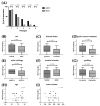A Protocol for Organoids from the Urine of Bladder Cancer Patients
- PMID: 37681920
- PMCID: PMC10487035
- DOI: 10.3390/cells12172188
A Protocol for Organoids from the Urine of Bladder Cancer Patients
Abstract
This study investigates the feasibility of establishing urine-derived tumor organoids from bladder cancer (BC) patients as an alternative to tissue-derived organoids. BC is one of the most common cancers worldwide and current diagnostic methods involve invasive procedures. Here, we investigated the potential of using urine samples, which contain exfoliated tumor cells, to generate urine-derived BC organoids (uBCOs). Urine samples from 29 BC patients were collected and cells were isolated and cultured in a three-dimensional matrix. The establishment and primary expansion of uBCOs were successful in 83% of the specimens investigated. The culturing efficiency of uBCOs was comparable to cancer tissue-derived organoids. Immunohistochemistry and immunofluorescence to characterize the uBCOs exhibited similar expressions of BC markers compared to the parental tumor. These findings suggest that urine-derived BC organoids hold promise as a non-invasive tool for studying BC and evaluating therapeutic responses. This approach could potentially minimize the need for invasive procedures and provide a platform for personalized drug screening. Further research in this area may lead to improved diagnostic and treatment strategies for BC patients.
Keywords: bladder cancer; organoids; personalized medicine.
Conflict of interest statement
The authors declare no conflict of interest.
Figures




References
-
- Sung H., Ferlay J., Siegel R.L., Laversanne M., Soerjomataram I., Jemal A., Bray F. Global Cancer Statistics 2020: GLOBOCAN Estimates of Incidence and Mortality Worldwide for 36 Cancers in 185 Countries. CA Cancer J. Clin. 2021;71:209–249. - PubMed
-
- Walz S., Aslani V., Sawodny O., Stenzl A. Robotic radical cystectomy–more precision needed? Curr. Opin. Urol. 2023;33:157–162. - PubMed
-
- Soukup V., Capoun O., Cohen D., Hernandez V., Babjuk M., Burger M., Comperat E., Gontero P., Lam T., MacLennan S., et al. Prognostic Performance and Reproducibility of the 1973 and 2004/2016 World Health Organization Grading Classification Systems in Non-muscle-invasive Bladder Cancer: A European Association of Urology Non-muscle Invasive Bladder Cancer Guidelines Panel Systematic Review. Eur. Urol. 2017;72:801–813. - PubMed
-
- Huguet J. Follow-up after radical cystectomy based on patterns of tumour recurrence and its risk factors. Actas Urol. Esp. 2013;37:376–382. - PubMed
-
- Ghoneim M.A., Abdel-Latif M., el-Mekresh M., Abol-Enein H., Mosbah A., Ashamallah A., el-Baz M.A. Radical cystectomy for carcinoma of the bladder: 2720 consecutive cases 5 years later. J. Urol. 2008;180:121–127. - PubMed
Publication types
MeSH terms
LinkOut - more resources
Full Text Sources
Medical

